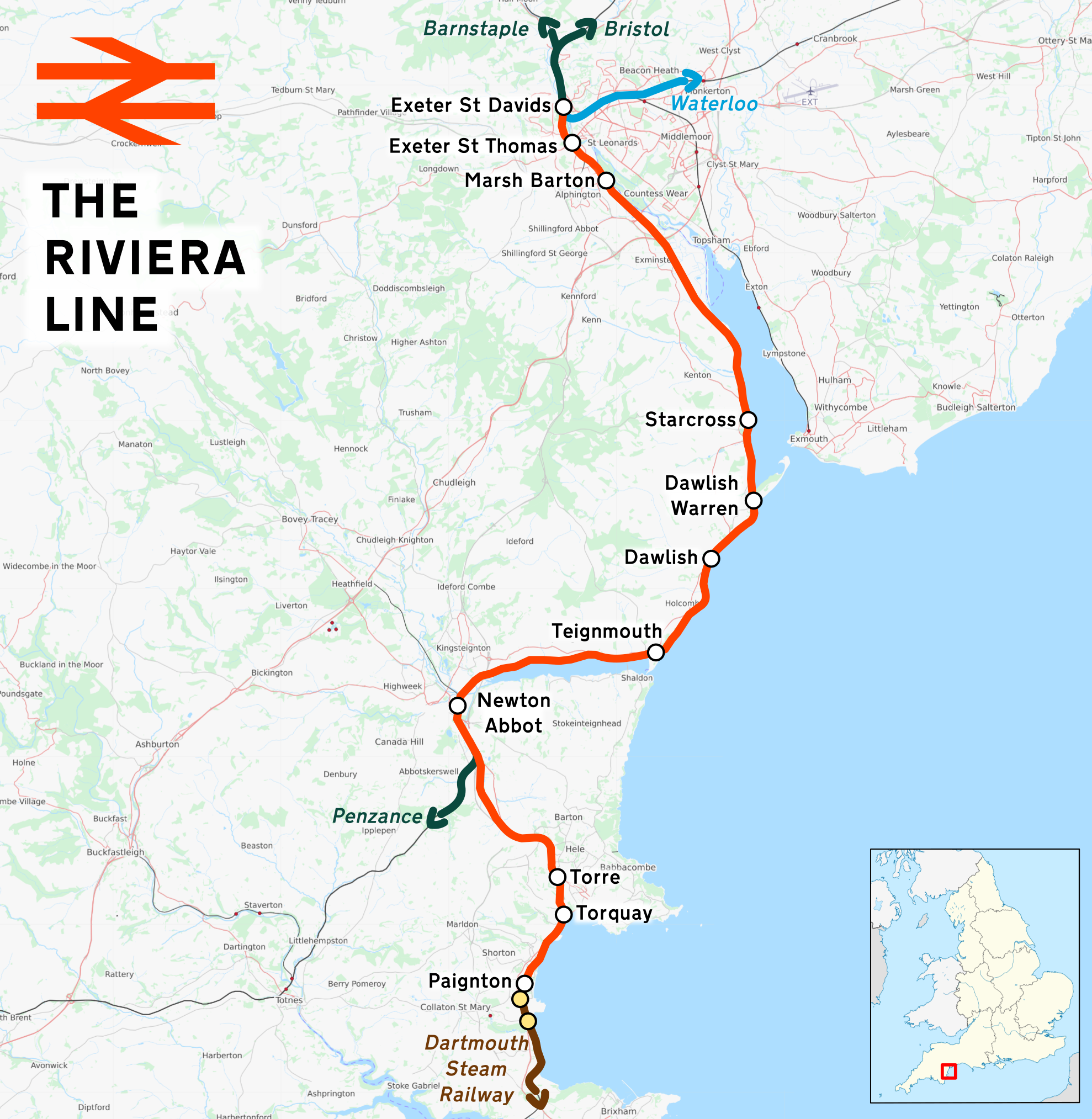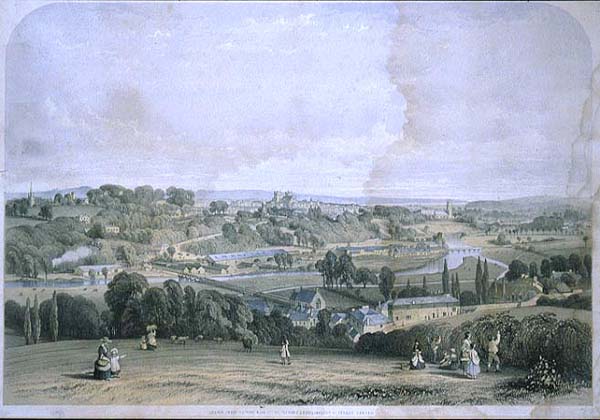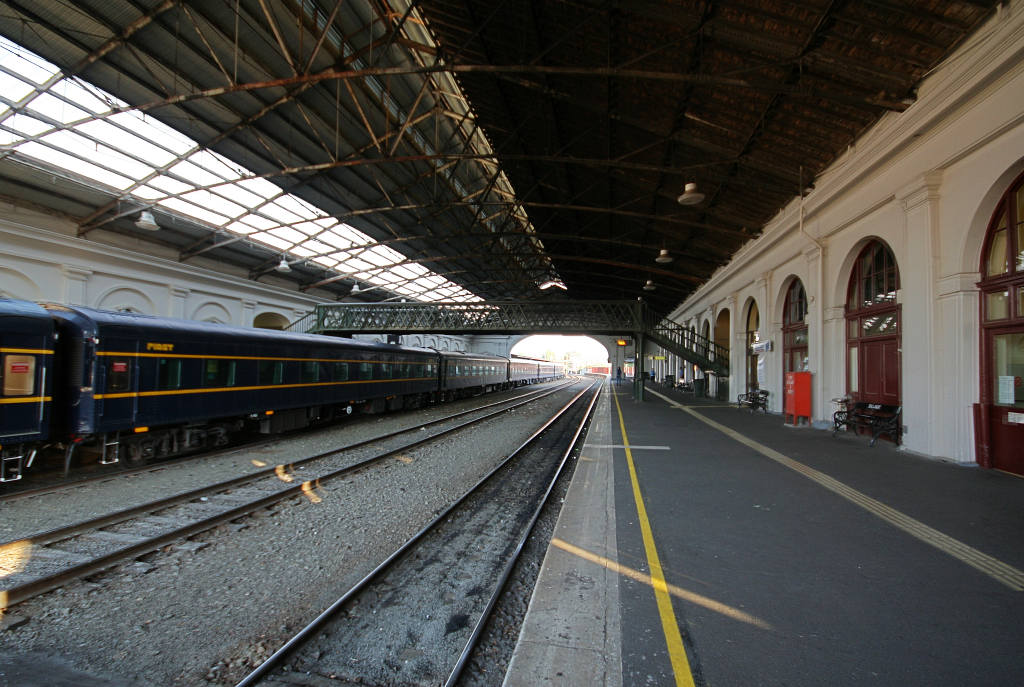|
Newton Abbot Railway Station
Newton Abbot railway station serves the town of Newton Abbot in Devon, England. It is from London, measured from the zero point at to the junction for the branch to . The station today is managed by Great Western Railway, who provide train services along with CrossCountry. For many years, it was also the junction for the branch line to Moretonhampstead and the site of a large locomotive workshop. History Broad gauge The station was opened by the South Devon Railway Company on 30 December 1846 when its line was extended from Teignmouth railway station. It was opened through to on 20 June 1847 and a branch to Torquay was added on 18 December 1848. The Moretonhampstead and South Devon Railway opened its branch line on 26 June 1866. All these railways used the broad gauge. Approaching the station from the town along Queen Street, people first saw the large goods shed. On the opposite side of the line was the pumping house for the atmospheric railway system that pow ... [...More Info...] [...Related Items...] OR: [Wikipedia] [Google] [Baidu] |
Percy Emerson Culverhouse
Percy Emerson Culverhouse (20 August 1871 – 7 May 1953) was the chief architect of the Great Western Railway from 1929 to 1945. Career He was born on 20 August 1871 to Eli Culverhouse (1828-1911) and Jane Mary Jones (1840-1919). At age 21 he was registered as a clerk at Paddington Station, working for the Great Western Railway. He progressed to Architectural Assistant to the New Works Engineer and in April 1929 was appointed Chief Architect to the Great Western Railway. He retired in September 1945 and was succeeded by Brian Lewis. He married Madeline Anina Ella Walker on 3 April 1902. He died on 7 May 1953 in Ealing, Middlesex leaving an estate of £8013 15s 6d (). Works * Bath railway station 1896 refreshment rooms alterations *Banbury railway station Banbury railway station serves the town of Banbury in Oxfordshire, England. The station is operated by Chiltern Railways, on the Chiltern Main Line, and has four platforms in use. History Banbury Bridge Street ... [...More Info...] [...Related Items...] OR: [Wikipedia] [Google] [Baidu] |
Torre Railway Station
Torre railway station is a suburban station on the Riviera Line in Torquay, Devon, England. It is measured from . The station is managed by Great Western Railway but is not staffed. The station buildings are Grade II listed. History A broad gauge branch was opened by the South Devon Railway from Newton Abbot on 18 December 1848, this station being the terminus and known as Torquay. This line was extended by the Dartmouth and Torbay Railway on 2 August 1859, which opened the present Torquay railway station at Livermead so the original station was renamed Torre. The station had a small extension to the single platform and a train shed built in 1855 but with the opening of the Dartmouth and Torbay Railway, a new platform had to be provided. The original station can still be seen standing alongside the track just north of the platform. Goods traffic was handled from October 1849. The goods yard was originally at the west end of the station. The original goods shed was destro ... [...More Info...] [...Related Items...] OR: [Wikipedia] [Google] [Baidu] |
0-4-0
Under the Whyte notation for the classification of steam locomotives, represents one of the simplest possible types, that with two axles and four coupled wheels, all of which are driven. The wheels on the earliest four-coupled locomotives were connected by a single gear wheel, but from 1825 the wheels were usually connected with coupling rods to form a single driven set. The notation 0-4-0T indicates a tank locomotive of this wheel arrangement on which its water and fuel is carried on board the engine itself, rather than in an attached tender. In Britain, the Whyte notation of wheel arrangement was also often used for the classification of electric and diesel-electric locomotives with side-rod-coupled driving wheels. Under the UIC classification used in Europe and, in more recent years, in simplified form in the United States, a 0-4-0 is classified as B (German and Italian) if the axles are connected by side rods or gearing and 020 (French), independent of axle motoring. T ... [...More Info...] [...Related Items...] OR: [Wikipedia] [Google] [Baidu] |
World War I
World War I (28 July 1914 11 November 1918), often abbreviated as WWI, was one of the deadliest global conflicts in history. Belligerents included much of Europe, the Russian Empire, the United States, and the Ottoman Empire, with fighting occurring throughout Europe, the Middle East, Africa, the Pacific, and parts of Asia. An estimated 9 million soldiers were killed in combat, plus another 23 million wounded, while 5 million civilians died as a result of military action, hunger, and disease. Millions more died in genocides within the Ottoman Empire and in the 1918 influenza pandemic, which was exacerbated by the movement of combatants during the war. Prior to 1914, the European great powers were divided between the Triple Entente (comprising France, Russia, and Britain) and the Triple Alliance (containing Germany, Austria-Hungary, and Italy). Tensions in the Balkans came to a head on 28 June 1914, following the assassination of Archduke Franz Ferdi ... [...More Info...] [...Related Items...] OR: [Wikipedia] [Google] [Baidu] |
Riviera Line
The Riviera Line is the railway between the city of Exeter, towns Dawlish and Teignmouth, and the ''English Riviera'' resorts of Torbay in Devon, England. Its tracks are shared with the Exeter to Plymouth Line along the South Devon sea wall. It is part of the Network Rail Route 12 ( to ). History The line from Exeter to was opened by the South Devon Railway Company on 30 May 1846 and was extended to on 30 December 1846. After the company had completed its main line to Plymouth, it opened a branch from Newton Abbot to Torquay (the present Torre railway station) on 18 December 1848. Nine years later, this was extended as the independent Dartmouth and Torbay Railway to on 2 August 1859. These lines were built as single-track, broad gauge railways by Isambard Kingdom Brunel. They were designed for atmospheric power and, although this was only used from 13 September 1847 until 9 September 1848, the remains of several of the South Devon Railway engine houses used for the st ... [...More Info...] [...Related Items...] OR: [Wikipedia] [Google] [Baidu] |
Standard Gauge
A standard-gauge railway is a railway with a track gauge of . The standard gauge is also called Stephenson gauge (after George Stephenson), International gauge, UIC gauge, uniform gauge, normal gauge and European gauge in Europe, and SGR in East Africa. It is the most widely used track gauge around the world, with approximately 55% of the lines in the world using it. All high-speed rail lines use standard gauge except those in Russia, Finland, and Uzbekistan. The distance between the inside edges of the rails is defined to be 1435 mm except in the United States and on some heritage British lines, where it is defined in U.S. customary/ Imperial units as exactly "four feet eight and one half inches" which is equivalent to 1435.1mm. History As railways developed and expanded, one of the key issues was the track gauge (the distance, or width, between the inner sides of the rails) to be used. Different railways used different gauges, and where rails of different gauge met � ... [...More Info...] [...Related Items...] OR: [Wikipedia] [Google] [Baidu] |
Consolidation (business)
In business, consolidation or amalgamation is the merger and acquisition of many smaller companies into a few much larger ones. In the context of financial accounting, ''consolidation'' refers to the aggregation of financial statements of a group company as consolidated financial statements. The taxation term of consolidation refers to the treatment of a group of companies and other entities as one entity for tax purposes. Under the Halsbury's Laws of England, 'amalgamation' is defined as "a blending together of two or more undertakings into one undertaking, the shareholders of each blending company, becoming, substantially, the shareholders of the blended undertakings. There may be amalgamations, either by transfer of two or more undertakings to a new company or the transfer of one or more companies to an existing company". Overview Consolidation is the practice, in business, of legally combining two or more organizations into a single new one. Upon consolidation, the origi ... [...More Info...] [...Related Items...] OR: [Wikipedia] [Google] [Baidu] |
Plymouth Millbay Railway Station
Plymouth Millbay railway station was the original railway terminus in Plymouth, Devon, England. It was used for passenger trains from 1849 to 1941. It was rebuilt in 1903. History The South Devon Railway Company, South Devon Railway originally planned to bring its broad gauge railway from Exeter St Davids railway station, Exeter St Davids to the Eldad area of Plymouth, terminating on a hill above Stonehouse Pool. In the event, it was redesigned to end at a station situated between Union Street, Plymouth, Union Street and Millbay itself. The railway reached a Laira railway station, temporary station at Laira on the eastern outskirts of Plymouth on 5 May 1848 and was extended to Millbay on 2 April 1849. At this time the station was just known as Plymouth as no other stations existed in the town. The station became known as "Plymouth Millbay" after other stations were opened in the town in 1876–7 at Mutley railway station, Mutley and Plymouth railway station, North Road. ... [...More Info...] [...Related Items...] OR: [Wikipedia] [Google] [Baidu] |
Exeter St Davids Railway Station
Exeter St Davids is the principal railway station serving the city of Exeter in Devon, England. It is from the zero point at on the line through Bristol which continues to Plymouth and Penzance. It is also served by an alternative route to London Waterloo via Salisbury and branch lines to Exmouth, Barnstaple, and Okehampton. It is currently managed by Great Western Railway and is served by trains operated by Great Western Railway, South Western Railway and CrossCountry. History The station was opened on 1 May 1844 by the Bristol and Exeter Railway (B&ER). The station was designed by Isambard Kingdom Brunel and was one of his single-sided stations which meant that the two platforms were both on the east side of the line. This was the side nearer the town and so very convenient for passengers travelling into Exeter but did mean that a lot of trains had to cross in front of others. This was not too much of a problem while the station was at the end of the line, but on 30 Ma ... [...More Info...] [...Related Items...] OR: [Wikipedia] [Google] [Baidu] |
Railway Platform
A railway platform is an area alongside a railway track providing convenient access to trains. Almost all stations have some form of platform, with larger stations having multiple platforms. The world's longest station platform is at Hubbali Junction in India at .Gorakhpur gets world's largest railway platform ''The Times of India'' The Appalachian Trail station in the United States, at the other extreme, has a platform which is only long enough for a single bench. Among some United States train conductors the word "platform" has entered [...More Info...] [...Related Items...] OR: [Wikipedia] [Google] [Baidu] |
Train Shed
A train shed is a building adjacent to a station building where the tracks and platforms of a railway station are covered by a roof. It is also known as an overall roof. Its primary purpose is to store and protect from the elements train cars not in use, The first train shed was built in 1830 at Liverpool's Crown Street Station. The biggest train sheds were often built as an arch of glass and iron, while the smaller were built as normal pitched roofs. The train shed with the biggest single span ever built was that at the second Philadelphia Broad Street Station, built in 1891. Types of train shed Early wooden train sheds The earliest train sheds were wooden structures, often with unglazed openings to allow smoke and steam to escape. The oldest part of Bristol Temple Meads is a particularly fine – and large – example, designed by Isambard Kingdom Brunel with mock-hammerbeam roof. Surviving examples include: * Ashburton, Devon, England (station closed) *Bo'ness, Fal ... [...More Info...] [...Related Items...] OR: [Wikipedia] [Google] [Baidu] |
Atmospheric Railway
An atmospheric railway uses differential air pressure to provide power for propulsion of a railway vehicle. A static power source can transmit motive power to the vehicle in this way, avoiding the necessity of carrying mobile power generating equipment. The air pressure, or partial vacuum (i.e., negative relative pressure) can be conveyed to the vehicle in a continuous pipe, where the vehicle carries a piston running in the tube. Some form of re-sealable slot is required to enable the piston to be attached to the vehicle. Alternatively the entire vehicle may act as the piston in a large tube or be coupled electromagnetically to the piston. Several variants of the principle were proposed in the early 19th century, and a number of practical forms were implemented, but all were overcome by unforeseen disadvantages and discontinued within a few years. A modern proprietary system has been developed and is in use for short-distance applications. Porto Alegre Metro airport connecti ... [...More Info...] [...Related Items...] OR: [Wikipedia] [Google] [Baidu] |








